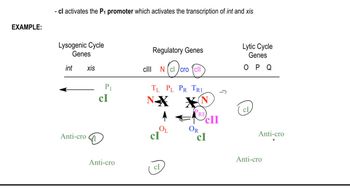The N protein is an anti-terminator. What does this mean?
Table of contents
- 1. Introduction to Genetics51m
- 2. Mendel's Laws of Inheritance3h 37m
- 3. Extensions to Mendelian Inheritance2h 41m
- 4. Genetic Mapping and Linkage2h 28m
- 5. Genetics of Bacteria and Viruses1h 21m
- 6. Chromosomal Variation1h 48m
- 7. DNA and Chromosome Structure56m
- 8. DNA Replication1h 10m
- 9. Mitosis and Meiosis1h 34m
- 10. Transcription1h 0m
- 11. Translation58m
- 12. Gene Regulation in Prokaryotes1h 19m
- 13. Gene Regulation in Eukaryotes44m
- 14. Genetic Control of Development44m
- 15. Genomes and Genomics1h 50m
- 16. Transposable Elements47m
- 17. Mutation, Repair, and Recombination1h 6m
- 18. Molecular Genetic Tools19m
- 19. Cancer Genetics29m
- 20. Quantitative Genetics1h 26m
- 21. Population Genetics50m
- 22. Evolutionary Genetics29m
12. Gene Regulation in Prokaryotes
Lambda Bacteriophage and Life Cycle Regulation
Problem 26b
Textbook Question
Suppose that base substitution mutations sufficient to eliminate the function of the operator regions listed below were to occur. For each case, describe how transcription or life cycle would be affected.
OR1 mutation in λ phage
 Verified step by step guidance
Verified step by step guidance1
Understand the context: The λ phage is a bacteriophage that can switch between the lytic and lysogenic life cycles. The operator regions (OR1, OR2, OR3) are DNA sequences where regulatory proteins bind to control transcription of genes involved in these life cycles.
Identify the role of OR1: OR1 is a binding site for the λ repressor protein (CI). When CI binds to OR1, it represses the transcription of the cro gene, which is essential for the lytic cycle. This helps maintain the lysogenic state.
Analyze the mutation: A mutation in OR1 that eliminates its function would prevent the λ repressor protein from binding to this site. Without CI binding to OR1, the cro gene would not be repressed.
Predict the effect on transcription: Since the cro gene is not repressed, its transcription would increase. The Cro protein promotes the lytic cycle by repressing the synthesis of the λ repressor (CI), leading to a shift toward the lytic life cycle.
Summarize the life cycle impact: The mutation in OR1 would disrupt the balance between the lytic and lysogenic cycles, favoring the lytic cycle. This means the phage would likely enter the lytic cycle, leading to the destruction of the host cell and the production of new phage particles.
 Verified video answer for a similar problem:
Verified video answer for a similar problem:This video solution was recommended by our tutors as helpful for the problem above
Video duration:
2mPlay a video:
Was this helpful?
Key Concepts
Here are the essential concepts you must grasp in order to answer the question correctly.
Operator Regions
Operator regions are specific DNA sequences where regulatory proteins bind to control the transcription of adjacent genes. In the context of phages like λ phage, these regions play a crucial role in determining whether the phage enters a lytic or lysogenic cycle, influencing gene expression and viral replication.
Recommended video:
Guided course

Regions of X Chromosomes
Transcription Regulation
Transcription regulation refers to the mechanisms that control the rate and timing of gene expression. In λ phage, the operator region interacts with repressor proteins, which can inhibit or promote transcription based on environmental signals, thus affecting the phage's life cycle and its ability to produce new virions.
Recommended video:
Guided course

Eukaryotic Transcription
Lytic vs. Lysogenic Cycle
The lytic and lysogenic cycles are two distinct pathways that a bacteriophage can follow after infecting a host. In the lytic cycle, the phage replicates rapidly, leading to cell lysis and release of new phage particles, while in the lysogenic cycle, the phage integrates its DNA into the host genome, remaining dormant until conditions trigger its reactivation.
Recommended video:
Guided course

Decision Between Lytic and Lysogenic Cycles

 4:29m
4:29mWatch next
Master Bacteriophage Life Cycle with a bite sized video explanation from Kylia
Start learningRelated Videos
Related Practice
Multiple Choice
295
views
1
rank
